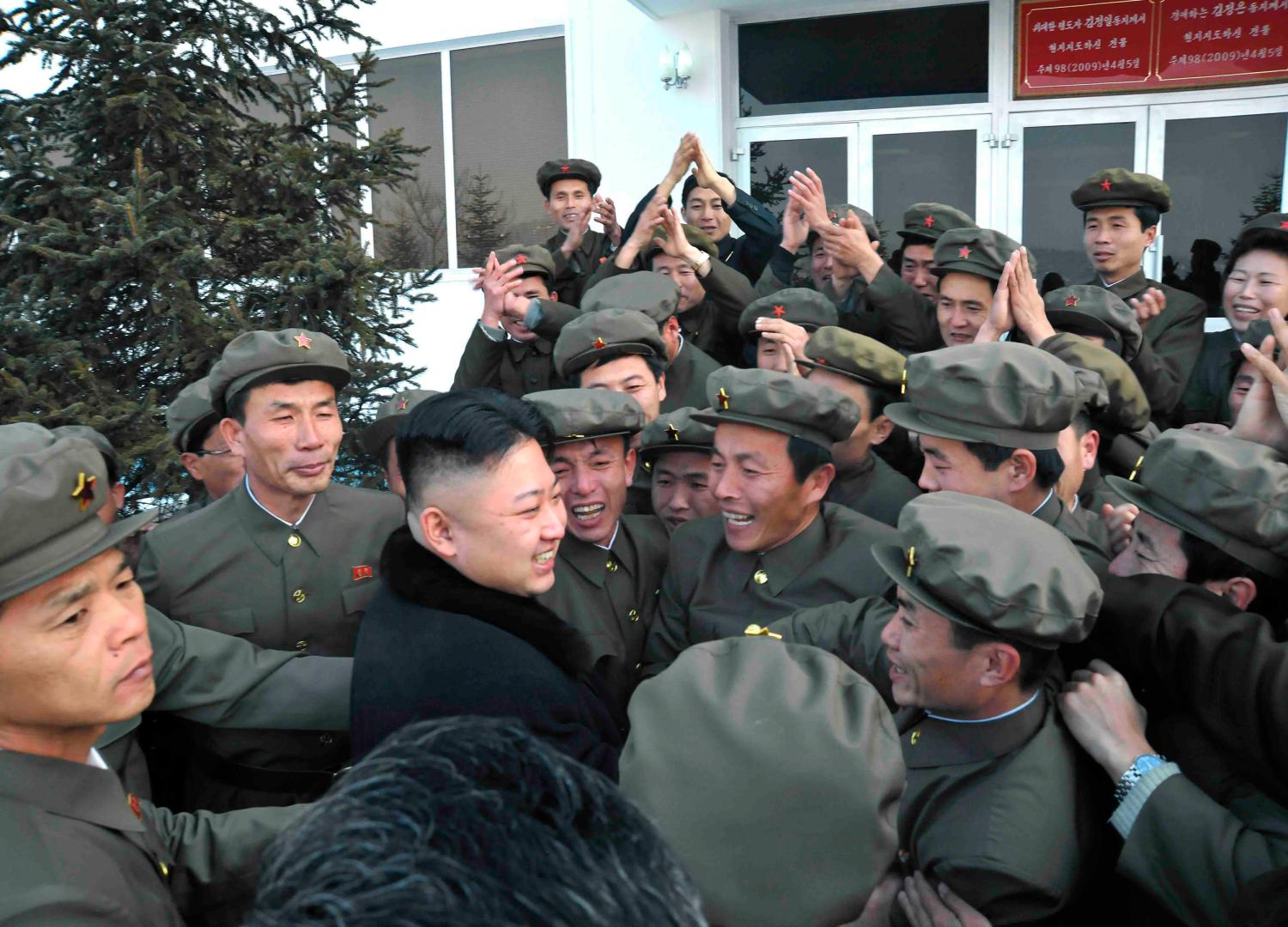North Korea’s severe internal crisis has impelled the United States and China to prepare to intervene in the North, even though neither Washington nor Beijing wants to re-ignite that conflict. Jonathan Pollack wrote this memorandum to President Obama as part of Big Bets and Black Swans: A Presidential Briefing Book.
- What are the ways Washington should engage with China to avoid conflict over North Korea and ensure the security of South Korea?
- How can China and the United States promote stability in the Korean peninsula?
Download Memorandum
(pdf) |
Download the Presidential Briefing Book
(pdf)
TO: President Obama
FROM: Jonathan D. Pollack
There is a serious risk of an acute U.S.-China confrontation or even a direct military conflict over Korea. Neither Washington nor Beijing seek this kind of conflict, but North Korea’s severe internal crisis has impelled the United States and China to prepare to intervene in the North, both to protect their respective vital interests and to forestall larger risks to the peace. Pyongyang has a long record of lashing out at neighboring states (especially our South Korean ally) to warn outside powers against any possible intervention in its internal affairs. But this threat now encompasses the potential use of nuclear weapons. Any possible nuclear use by North Korea, even if undertaken within its own borders, represents an acute danger to the region as a whole. If Washington and Beijing fail to coordinate and communicate, we could face the possibility of a U.S.-China confrontation almost unimaginable in its consequences.
Recommendation:
To reduce the risks of a confrontation with China over North Korea, you should instruct your administration to pursue four objectives with Beijing:
1. For both sides to disclose information on the location, operation and capabilities of each other’s military forces that could rapidly intervene in North Korea;
2. To share intelligence on the known or suspected locations of North Korea’s WMD assets, especially its nuclear weapons and fissile material holdings;
3. To initiate planning for the evacuation of foreign citizens in South Korea; and
4. To discuss possible measures to avoid an acute humanitarian disaster among North Korean citizens seeking to flee their country.
Background:
The immediate need for the United States and China is to discuss North Korea and control the risks of conflict well beyond what the U.S. has attempted with Beijing in the past. In addition, we need to cooperate to mitigate the potential dangers to American and Chinese citizens living or working in the Republic of Korea (ROK) and to reduce the risks of a direct clash between U.S. and Chinese forces to as close to zero as possible. This will require discussions on military deployments and operations unprecedented in their scope and candor. South Korea must also be part of this conversation.
Despite repeated incidents and potential crises over the decades, the U.S. has been able to maintain an uneasy, heavily-armed peace on the peninsula. In 1972, President Nixon reminded Premier Zhou Enlai that the United States and China fought once in Korea, and that both countries must ensure that this never happens again.
However, deterrence no longer suffices to constrain Pyongyang. North Korea’s citizens are now fleeing in large numbers across the 38th Parallel and into China, and the regime’s very survival is at stake. The internal crisis means that the North Korean leadership is prepared to do whatever it deems necessary to prevent a final meltdown of the regime. Since the 1990s, the U.S. has sought to open a serious conversation with Beijing about the possibility of a major crisis on the peninsula, but China’s leaders (perhaps to avoid offending leaders in Pyongyang or perhaps out of deep suspicions of American intentions) have repeatedly refused to enter into such discussions. But the long-feared crisis is at hand. Unless Washington and Beijing are prepared to discuss these issues directly, the prospect of a second Sino-American confrontation on the peninsula becomes a distinct possibility.
The United States presently has 28,500 active duty personnel deployed in South Korea, and can surge another several hundred thousand personnel onto the peninsula in the event of a major military contingency. Beginning in the late 1990s, the United States and the ROK began to augment longstanding war plans embodied in variants of OPPLAN 5027 with additional planning for abrupt internal change in the North, now addressed under OPPLAN 5029. Until now, Washington and Seoul have tried to secure the borders of the North in an effort to stem any massive flows of North Korean citizens across the demilitarized zone (DMZ). China has undertaken comparable steps to seal its much more porous border with the North. But the current crisis threatens to overwhelm both sides, and Beijing appears alarmed by evidence of the northward redeployment of U.S. and ROK forces. The risks of misperception and miscalculation have increased greatly. American moves are not intended to pose threats to China, but to address the mounting risks of instability in North Korea spilling outward. The U.S. should communicate this fully and openly with China, simultaneously seeking clarification of Chinese plans and intentions.
The safety and security of North Korea’s WMD assets are the uppermost concern of the United States. The command and control arrangements in North Korea are under increasing stress, and it is no longer clear that the central authorities retain full control over the operation of all military units. Any loss of control could create incalculable risks to both the United States and China. It is imperative that you undertake urgent consultations with Beijing to ensure that neither the U.S. nor China misconstrues the other’s actions and plans. Equally important, the United States, China, and Russia have shared interests as nuclear weapon states to prevent any leakage of nuclear materials, technology or completed weapons beyond North Korea’s borders. At the same time, you should convey to Beijing that it must unambiguously warn Pyongyang of the potential consequences of any nuclear use or threatened nuclear use. North Korea’s testing of nuclear weapons is a major worry under all circumstances, but to undertake a test under crisis conditions represents an intolerable risk.
Threats to the lives and well-being of foreign citizens in the ROK also warrants urgent consultation and expanded cooperation between the United States and China. According to South Korean government data, there are 1.4 million foreigners in the country at present. These include 130,000 American citizens as well as nearly 30,000 in-country military personnel. Nearly half of the foreigners residing in South Korea (670,000) are from China. The upheavals since the Arab spring have sobered leaders in Beijing to unanticipated risks to Chinese citizens living abroad. The scale of the crisis unfolding in China’s backyard is altering the calculus of Chinese officials. Equally important, China has major capabilities for evacuating foreign nationals. There are now 200 flights a day between cities in South Korea and cities in China, as well as ferries that regularly traverse the Yellow Sea and the Bohai Gulf. These create possibilities to mitigate the potential risks to foreign nationals – Chinese, American, and others – that will be incalculably less effective in the absence of active cooperation with China.
Finally, the humanitarian needs cannot be ignored. China has long conveyed strong opposition to the responsibility to protect (R2P), but R2P in the context of acute instability in North Korea should concentrate the minds of leaders in Beijing. This will be as much China’s problem as it will be for any other state. Though the U.S. should not hesitate to bring this issue to the United Nations, there is every reason for private consultations with Beijing, ideally led by the ROK. Seoul will bear a disproportionate burden for dealing with the aftermath of the crisis. But Chinese interests are also deeply engaged. It cannot stand in the way of managing the consequences.
Conclusion:
For more than two decades, the United States and South Korea have tried to address the implications of instability in North Korea, all the while as China has sought to maintain an arm’s length posture and preserve North Korea’s existence as a separate state. But the unraveling of the North is no longer a hypothetical possibility. The United States and China have a compelling shared interest that the immediate crisis not morph into something far worse, and this must be your bottom-line message to leaders in Beijing.




